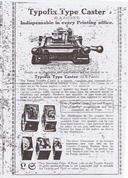At present, all we have are scattered fragments of information about this machine.

Typofix Type-Caster
A brochure and instruction manual, in English.
This is a PDF which I processed (slightly) and assembled from scans of a photocopy of a brochure supplied by Patrick Goossens. (If the final page of it appears to be a different color, that is because you are viewing it with Adobe's acrobat reader, which cannot, apparently, correctly display a PDF.) Since the photocopy itself is difficult to read, and it is possible that my digital processing has obscured some detail, here are the original JPEG images that Patrick sent to me:
A different digital presentation of what is probably a version of the same original (multigenerational) photocopy is online at the The Metal Type Library (UK): www.metaltype.co.uk/library.shtml.
I have not yet been able to track down the Deutsches Reich patent this brochure refers to.
There was a thread on BriarPress starting in April 2012 in which a Typofix was illustrated photographically: http://briarpress.org/30114
The machine shown in this thread bears the name "Trader Horn" cast into its base. The Melbourne Museum of Printing, in Australia, lists (but does not illustrate) two such casters in their collection, under the name "Trader Horn Hand-caster." ( http://home.vicnet.net.au/~typo/collect/typemach/handcast.htm)
On 2011-09-23, a Typofix sold on Ebay, from a seller in France in US Ebay auction number 230674603369. The winning bid was EUR 121.00, which was about US$162 at the time.
A Google Books scan, viewable in snippet form only, contains a fragment from an unidentified number of the journal Printing in 1929: "He has just purcased a Typofix Type caster, a German machine for duplicating foundry characters and small cuts."
Another Google Books scan might cast some light on the identity of either the German inventor or, at least, promoter of this machine. From the Archiv für buchgewerbe und gebrauchsgraphik... Vol. 64, Issues 1-4, p. 271 (Leipzig: Deutscher Buchgewerbeverein, 1927):
"Johannes H. Freyberg, Leipzig, zeigte den Hand- Typen-Gießapparat „Typofix", mit dessen Hilfe es möglich ist, neue Lettern aus altem Schriftmetall in beliebiger Menge zu gießen. Auch hier handelt es sich bei den Ausstellungen im ..."
Google Translate renders this:
"Johannes H. Freyberg, Leipzig, showed the hand-type casting apparatus "Typofix", by which it is possible to cast new letters from old metal letters in any quantity. Again, it is at the exhibitions ..."
In a posting to the LETPRESS list on 2000-10-14, Justin Howes notes: "... the German-made Typofix Type-Caster, D.R. Patent and presumably inter-war, was designed to make duplicating type easier. The mechanism itself is a mold, adjustable for [set] width and [body, not type] height of the letter. The key to the systme was that both the original type, and the lead matrix made from it, were to be coated in lamp black by being held in the smoke-produced by a small oil lamp supplied with the machine. That being done, it can make type up to 96-point ... the same dimensions as the original, and preserving any kerns." Howe said that he had a Typofix, and that there was one at the St. Bride's library.
Note: Apparently, in the former East Germany the trade name "Typofix" was used for a form of dry transfer lettering. See Osterer, Heidrun and Phillip Stamm, eds. Adrian Frutiger Typefaces: The Complete Works ([location?]: Walter de Gruyter, 2009): 223. This is available online in preview form via Google Books. The chances of any relationship of this to the Typofix caster are slight.
The Typofix Type-Caster brochure reprinted here from scans by Patrick Goossens, in Belgium, is in the public domain in England, German, and Belgium. If it was published before 1926 in England, or if it was published at all in the US, it is also in the public domain in the US. I am presuming that it was published before 1926 in England.
All portions of this document not noted otherwise are Copyright © 2013 by David M. MacMillan and Rollande Krandall.
Circuitous Root is a Registered Trademark of David M. MacMillan and Rollande Krandall.
This work is licensed under the Creative Commons "Attribution - ShareAlike" license. See http://creativecommons.org/licenses/by-sa/3.0/ for its terms.
Presented originally by Circuitous Root®
Select Resolution: 0 [other resolutions temporarily disabled due to lack of disk space]